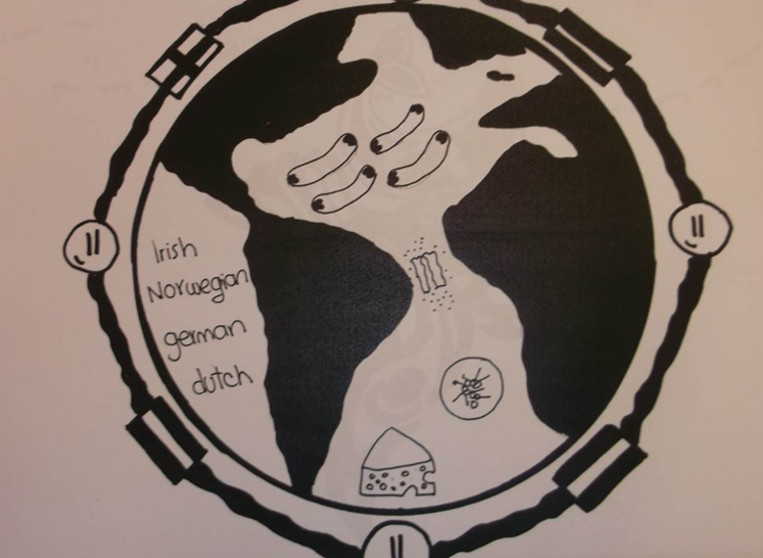Language Borders
Language Arts - Grade 12
This unit of inquiry is not a recipe book but rather a launchpad to inspire new BIG IDEAS. We encourage you to use and/or modify one, or several of the BIG IDEAS below. Adapt it to the grade/ ability level of your students.
Enduring Understandings
Language barriers can be overcome.
Guiding Questions
How can we cross the borders of language within literature and poetry?
Mind Opening
Choose or devise practices to encourage students to be open to new experiences and ways of thinking in your classroom. For example, the MindUP in-school program.
Discovery and Inspiration:
Launch the Project
• Introduce the Theme: Present the Enduring Understanding and Guiding Questions using vocabulary that is appropriate for your grade level.
• About Vancouver Biennale: Play a short video.
• Create Project Space: Brainstorm ideas to make the project theme visual and visible using bulletin boards, and/or a project corner to share relevant materials and inquiry questions and processes.
Reference Resources:
• Introduction to Sculpture and Public Art Unit Plan for information on how art has evolved over time and the unique experience sculptures and/or public art brings
• Vancouver Biennale 2014-2016 Exhibition Theme: Open Borders / Crossroads Vancouver
• We, 2008 (Jaume Plensa) from the Vancouver Biennale 2009 – 2011 Exhibition
• About Artist and Artwork (PDF)
Learning to Learn:
Art Inquiry
Project images of We, 2008 and encourage students to freely explore and interact with the art pieces individually and in groups. This Art Inquiry process enables the students to practice observing, describing, interpreting, and sharing visual information and personal experiences. Use the Art Inquiry Worksheet (PDF) to guide and capture their ideas and impressions. Customize or create your own Art Inquiry Worksheet as appropriate for your project and class needs.
Shared Insights
• Sharing Art Inquiry Experience: Ask students to share the Art Inquiry Worksheet responses in class.
• Artist Themes – Research: In small groups students rotate between information stations detailing the artist’s life and work. Station topics include: (1) education and training; (2) lifetime of artwork; (2) materials and processes; (3) beliefs and values. At each station, students answer questions and complete a task. For example, at the station “life’s work” students might plot the artist’s various installations on a map of the world.
• Artist Themes – Language Borders: Referring to We, 2008 and ask students to identify linguistic symbols that they know or familiar with. Ask students if they are aware of any universal symbols that cross the borders of language? Lead a discussion on whether the artist manage to represent an infusion of multiple languages through this art piece. Look up other art installations by the artist and relate the use of different art media/forms to crossing borders of language.
Inquiry Challenges
Connotation & Denotation: Draw a heart on the board and ask the students the first words that they think of when they see the heart. Then write them randomly on the board as the students shout out their answers. Categorize into Connotation and Denotation so students know the difference between the two definitions. Inform students that you will work with solely connotation rather than denotation when it comes to poetry
Discovery Assignment: Students will write a ‘Bio Poem’ in the following format to introduce them into poetry:
Line 1: First Name
Line 2: Four Descriptive Traits
Line 3: Sibling of…
Line 4: Lover of…
Line 5: Who fears …
Line 6: Who needs …
Line 7: Who gives …
Line 8: Who would like to see …
Line 9: Resident of …
Line 10: Last Name
Language Arts: Spanish – Cruzando Fronteras/French
Have students read Spanish poems and translate them trying to keep the aesthetic beauty of the language. Encourage students to write and present their own poem written in Spanish. (Samples from Pablo Neruda, Federico Garcia Lorca, and Antonio Machado)
Student Creations and Taking Action
The students could perform their Spoken Word creation. They could rap their work, incorporate music, dance, and involve the audience in their performance.
Students can schedule an evening when they can invite members of the community for a poetry slam night. They are encouraged to invite other students from other classes to come and read poetry and share their work with others. If the Art 12 class is involved with the English 12 class, the art creations can be exhibited and students can have the option to share their poetry with the artwork.
Reflection
• Teacher and students can reflect on their entire learning process by revisiting the Enduring Understanding and relevant Guiding Questions.
• How did the unit of study open inquiry, create cross–curricular learning opportunities and/or apply learning to real life situations? Has this unit of inquiry changed your opinions, values and world view? In what ways, if any, has it helped you grow as a learner?
Ideas for Cross-Curricular Access
• Arts Education – Drama & Music: Have students choose a medium to respond to the writer’s work through a means of poetic/aesthetic expression. View the Biennale 2012 Performance Video Youth Street Dance Council – Instructions for a Bad Day as an inspiration [View Video].
• Arts Education – Spoken Words through Art: Partner with the English 12 class to create an art form of what the writer wants to express in his/her poem. Students to have total freedom on the artistic direction with close collaboration between the writer and the artist.
• Social/History – Comparative Civilization: Have students look for poetry in historical moments such as war poetry. Compare poetic themes across cultures.
Credits
Written by: Stephanie Moreno, 2013 UBC Secondary School Teacher Candidate
Edited by: Jennifer Massoud, Secondary School Teacher
©2013 Vancouver Biennale
Related Material
 Howe Sound Gr 10 – 12 & Squamish Gr 6/7
Howe Sound Gr 10 – 12 & Squamish Gr 6/7